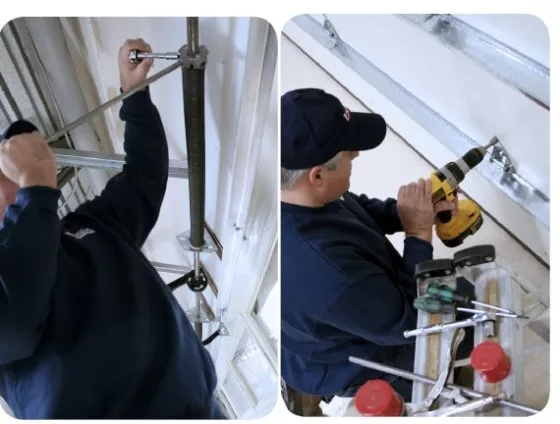
Spring break is usually a period of intense fun. However, not all spring breaks are good times. The one we are talking about will most likely produce a sudden, loud noise but is not followed by any fun at all. This noise resembles a gunshot. That sound will come from your garage. After your heart stops pounding and you get the courage to look around, you may not find evidence of the source of the sound. However, the next time you try to operate your garage door, things don’t seem to be working right, and for the first time, you hear a strange, irregular noise. When you raise your eyes up, you discover that the lifting spring for your garage door has broken into two pieces!
Critical Spring System
Before explaining how a massive spring like this can break, it is important to discuss what the spring system is used for. This informative background information will help you understand how it can malfunction. When discussing residential garage doors, there are two types of systems:
-
Torsion spring
This kind of spring is placed inside of a steel tube over the head of the door which is securely attached to the wall. All of the weight of the garage door is transferred to the anchor plate placed at the center of the door. It may have been that the headroom over your door is insufficient. In this case, the plate may need to be placed at the end of the horizontal tracks. When this is done, it is called a low headroom or double horizontal track system.
-
Extension spring
These springs, located on each side of the garage door, are placed over the horizontal tracks. As their name implies, their coiled form “extends” to lift or lower the garage door. A good, experienced garage door professional will always install safety cables with extension springs. In the case where a spring breaks, this cable will stop the spring from hitting something else in the garage or falling onto your car, both potentially dangerous and expensive.
A properly balanced garage door should weigh between eight and 10 pounds or 3.5 and 4 kg. This should be true even with an electric garage door opener because the garage door opener is only meant to take the place of manual effort. However, don’t forget that if on one hand, a door opener is able to lift such weight, it is more than able, on the other hand, to push down with the same force. So make sure you don’t end up in its path when it’s descending or someone may get injured.
Why Does the Spring Break?
There are several causes. Here are the primary ones:
-
Environmental conditions
Even with insulation garages are typically cold and humid. Even if the spring is insulated and the environment is heated, springs are still usually located near exterior walls. This means the springs are often cold and damp. These conditions leave the spring vulnerable to rust and dry rot.
-
Little or no maintenance from the homeowner
Garage doors and their lifting systems require some upkeep. It is recommended twice-yearly lubrication of metal parts that come into contact with other ones, once in the fall or winter when temperatures start dipping below 32 0 F (0 0 C) and the other when temperatures at night are above freezing.
-
Wear
A spring’s lifespan is between 5 and 7 years. A large number of garage door manufacturers offer 10,000‑cycle spring systems. A cycle is one opening and one closing of the garage door. If you use your garage door daily, it most likely is used between 2 to 4 times a day. This normal, everyday use translates to 1,500 cycles a year. If you use your garage door more than 5 times a day, you may need a 20 to 25,000 cycles spring. These are available from some manufacturers
-
Improper spring calibration
Every now and then, the right spring system is not installed. While the door will still open and close, more stress can be placed on the spring, door and opener. Springs are calibrated to operate properly with a 5% variation so that a spring made to lift a 100‑lb. (45‑kilo) door is not to be used with a spring for a 150‑lb. (68‑kilo) door.
-
Manufacturing Defect
In the case of extension springs, it would most likely be the ring at the end of the spring that breaks over time. For torsion springs, it would be low-quality galvanizing against rust that could cause this problem.
Maintenance Advice
Lubricating the springs is very important. This should be done at least once a year, but ideally it should be done twice a year. Use a petroleum-based oil like motor oil (ex.10W30) and apply completely around the coils with a cloth. After doing this, wipe off any excess. Doing this will help get rid of the clinking noise that springs often make while they are stretching and releasing. As a rule, never use WD-40 because it is a degreaser. It should not be used for lubricating springs or any other metal parts. There are lubricants available specifically from garage door dealers.
Reach out and contact us. We have many years of experience and know garage doors better than anyone else. We can offer advice and can also explain the best choice to make based on your needs and budget. We can also send you a quotation via email for your convenience.
Come by and visit our showroom. If you would like to change your garage door, use our Design Centre to find the style for your home. You can also search through our image gallery for more ideas.
If you have a busy schedule and cannot do garage door maintenance, we offer a “Garage Door Tune‑up” program. It is similar to the way a car dealership will offer one for your vehicle to avoid problems before and during winter.








Add new comment